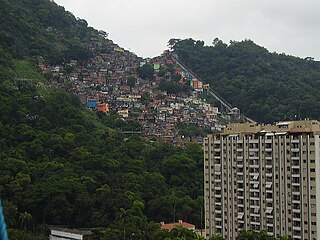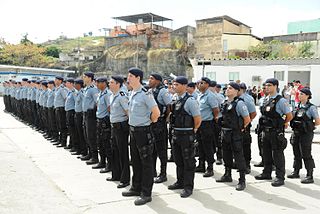Related Research Articles

Favela is an umbrella name for several types of working-class neighborhoods in Brazil. The term, which means slum or ghetto, was first used in the Slum of Providência in the center of Rio de Janeiro in the late 19th century, which was built by soldiers who had lived under the favela trees in Bahia and had nowhere to live following the Canudos War. Some of the first settlements were called bairros africanos. Over the years, many former enslaved Africans moved in. Even before the first favela came into being, poor citizens were pushed away from the city and forced to live in the far suburbs.

Rocinha is the largest favela in Brazil, located in Rio de Janeiro's South Zone between the districts of São Conrado and Gávea. Rocinha is built on a steep hillside overlooking Rio de Janeiro, and is located about one kilometre from a nearby beach. Most of the favela is on a very steep hill, with many trees surrounding it. Around 200,000 people live in Rocinha, making it the most populous favela in Brazil.
Erismar Rodrigues Moreira, also known as "Bem-Te-Vi", was a gang leader in the Brazilian slum Rocinha, in Rio de Janeiro. He was considered to be the most wanted criminal in Rio during his prime.
Primeiro Comando da Capital is, according to a 2012 Brazilian Government report, the largest Brazilian criminal organization, with a membership of almost 20,000 members, 6,000 of whom are in prison.
Kátia Lund is a Brazilian film director and screenwriter. Her most notable work was as co-director of the film City of God.

Comando Vermelho, also known as C.V., is a Brazilian criminal organization engaged primarily in drug trafficking, arms trafficking, protection racketeering, kidnappings-for-ransom, armored truck hijackings, loansharking, irregular warfare, narco-terrorism, and turf wars against rival criminal organizations, such as Primeiro Comando da Capital and Terceiro Comando Puro. The gang formed in 1979 out of a prison alliance between common criminals and leftist guerrillas, who were imprisoned together at Cândido Mendes. The prisoners formed the alliance to protect themselves from prison violence and guard-inflicted brutality; as the group coalesced, the common criminals were infused with leftist social justice ideals by the guerrillas. In 1979, prison officials labeled the alliance “Comando Vermelho,” a name which the prisoners eventually co-opted as their own. In the 1980s, the gang expanded beyond Ilha Grande into other prisons and the favelas of Rio de Janeiro, and became involved in the rapidly growing cocaine industry. Meanwhile, Brazil’s shift towards democracy and the eventual end of the military dictatorship in 1985 allowed the leftist guerrillas to re-enter society; thus, the CV largely abandoned its left-wing ideology.
Proibidão, which literally translates to "strongly prohibited", is a subgenre of funk carioca music originating from the favelas of Rio de Janeiro where it began in the early 1990s as a parallel phenomenon to the growth of drug gangs in the many slums of the city. The drug gangs sponsored DJs and baile funks in the favelas they controlled to spread respect and love for their gang as well as hate to the other gangs. The music that resulted is proibidão.

Crime in Brazil involves an elevated incidence of violent and non-violent crimes. Brazil's homicide rate was 27.4 per 100,000 inhabitants, according to the United Nations Office on Drugs and Crime (UNODC). Brazil has the highest number of intentional homicides in the world, with 57,358 in 2018, or possibly second to Nigeria, which lacks accurate data but was estimated at 64,201 in 2016. In recent years, the homicide rate in Brazil has begun to decline. The homicide rate was 20.64 per 100,000 in 2020 with 43,879 killings, similar to 2019, but down from 30.67 per 100,000 in 2017.

Vidigal is a neighborhood and a favela in Rio de Janeiro, Brazil.

The Morro da Babilônia is a hill in the Leme neighbourhood of Rio de Janeiro, separating Copacabana beach from Botafogo. It is home to a favela known by the same name, as well as the favela Chapéu Mangueira. Morro da Babilônia is an environmentally protected area.
The Military Police of Rio de Janeiro State (PMERJ) like other military polices in Brazil is a reserve and ancillary force of the Brazilian Army, and part of the System of Public Security and Brazilian Social Protection. Its members are called "state military" personnel.

Favela Santa Marta is a favela located in the Botafogo and Laranjeiras part of the Morro Dona Marta, that is also divided with the neighborhoods of Flamengo, Cosme Velho and Silvestre, in the South Zone of Rio de Janeiro, Brazil. It has about 3,913 residents and 1,287 domiciles, with 500 wooden houses, 2,000 brick houses, 4 kindergartens, 3 bakeries, 2 sports fields, 1 block of a samba school, 3 military units and 1 small market. The favela is one of the steepest in the city, with an altitude of 352 metres (1,155 ft), approximately 45 degrees of inclination and occupies an area equivalent to 53,706 square metres (578,090 sq ft).

The Pacifying Police Unit, abbreviated UPP, is a law enforcement and social services program pioneered in the state of Rio de Janeiro, Brazil, which aims to reclaim territories, most commonly favelas, controlled by gangs of drug dealers. The program was created and implemented by State Public Security Secretary José Mariano Beltrame, with the backing of Rio Governor Sérgio Cabral. The stated goal of Rio's government is to install 40 UPPs by 2014. By May 2013, 231 favelas had come under the UPP umbrella. The UPP program scored initial success expelling gangs, and won broad praise. But the expensive initiative expanded too far, too fast into dozens of favelas as state finances cratered, causing a devastating backslide that enabled gangs to recover some of their lost grip.
Terceiro Comando is a Brazilian criminal organization engaged in drug trafficking in Rio de Janeiro. It was founded in the early 1980s and is a break-away faction of the Comando Vermelho.
The 2017 Brazil prison riots were a confrontation between two criminal organizations, the Primeiro Comando da Capital (PCC) and Comando Vermelho (CV), and their allies within prisons and peripheries of Brazilian cities. Its emergence is linked to the methods of the PCC to conquer new territories for drug trafficking, which involve the collection of insurance and economic centralization and whose rigid pseudo-state organization finds strong resistance from regional criminal organizations, with predominantly decentralized organization.
The Santa Cruz Cartel is a Bolivian drug cartel and criminal organization, said to be one of the largest in the country, headquartered in Santa Cruz de la Sierra.
Brazilian militias, mainly in Rio de Janeiro, and some other cities of Brazil, are illegal mafia-like paramilitary groups made up of current and former police officers as well as Military Firefighters Corps officers, criminals, politicians, and military officers, operating also as a regular mafia by trade extortion and political influence.
The Altamira prison riot occurred on 29 July 2019, when a riot broke out at the Centro de Recuperação Regional de Altamira prison in Altamira, Pará, Brazil due to drug turf disputes between rival gangs within the prison.

Elias Pereira da Silva, also known as Elias Maluco, was one of Rio de Janeiro's most powerful drug traffickers. Maluco, a member of the criminal faction Comando Vermelho, commanded drug trafficking in thirty slums in the vicinity of Complexo do Alemão and Penha, Brazil. He was accused of killing over sixty people.

The armed conflict for control of the favelas in Greater Rio de Janeiro is an ongoing continuous, since 2006, armed conflict between Brazilian militias and subgroups, Primeiro Comando da Capital, Comando Vermelho, Amigos dos Amigos, Terceiro Comando Puro and the government.
References
- 1 2 3 "Amigos dos Amigos". InSight Crime. March 30, 2018. Archived from the original on 21 December 2018. Retrieved 5 November 2018.
- ↑ "Rio's post-Olympic blues". The Economist . 5 October 2017. Archived from the original on 6 October 2017. Retrieved 6 October 2017.